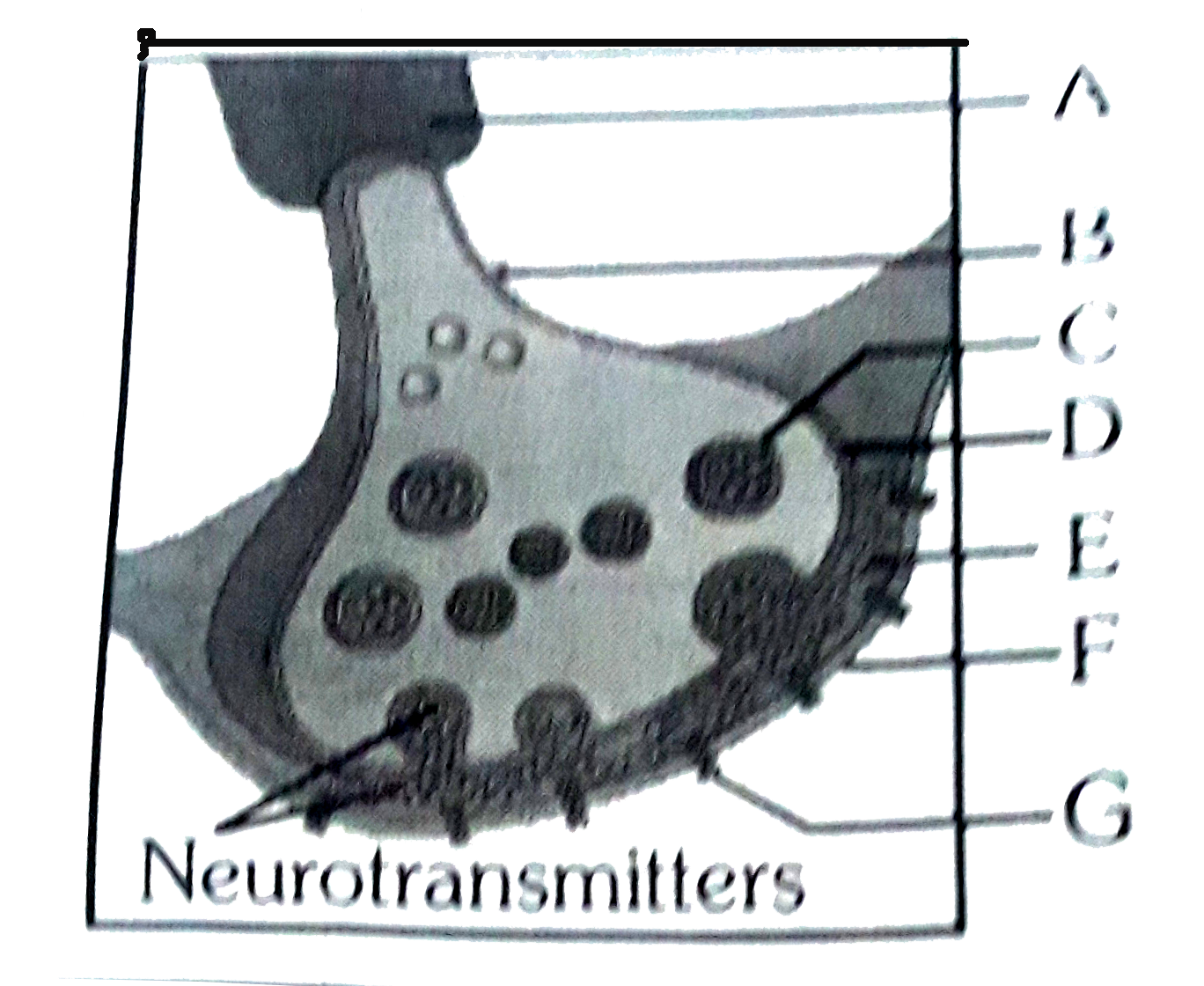Expalin the process of the transpot and relase of a neurotransmitter with the help of a labelled diagram showing a complete neuron, axon terminal and synapse.
Step-by-Step Solution
1. Understanding Neurons: Neurons are the functional units of the nervous system responsible for transmitting signals. They consist of three main parts: dendrites, the cell body, and the axon.
2. Structure of a Neuron:
- Dendrites: These are branch-like structures that receive signals from other neurons.
- Cell Body: Contains the nucleus and organelles.
- Axon: A long projection that transmits signals away from the cell body.
- Axon Terminal: The endpoint of the axon where neurotransmitters are stored in vesicles.
3. Synapse: The synapse is the junction between two neurons, consisting of the presynaptic knob (axon terminal of the sending neuron), the synaptic cleft (the gap between the two neurons), and the postsynaptic knob (the receiving neuron).
4. Transport of Neurotransmitters:
- Neurotransmitters (e.g., acetylcholine) are synthesized and stored in vesicles within the axon terminal.
- When an electrical signal (action potential) travels down the axon and reaches the axon terminal, it triggers the opening of calcium channels.
5. Release of Neurotransmitters:
- The influx of calcium ions into the axon terminal causes the vesicles containing neurotransmitters to move towards the presynaptic membrane.
- The vesicles fuse with the presynaptic membrane and release neurotransmitters into the synaptic cleft through a process called exocytosis.
6. Binding to Receptors:
- The released neurotransmitters diffuse across the synaptic cleft and bind to specific receptors on the postsynaptic knob of the next neuron.
- This binding causes depolarization of the postsynaptic neuron, which may lead to the generation of a new action potential, thus transmitting the signal to the next neuron.
7. Termination of Signal:
- After the neurotransmitters have acted on the receptors, they are either broken down by enzymes or reabsorbed by the presynaptic neuron for recycling.
Diagram Description
- Labelled Diagram: A complete neuron should be illustrated, showing:
- Dendrites
- Cell body
- Axon
- Axon terminal (presynaptic knob)
- Synaptic cleft
- Postsynaptic knob with receptors
- Vesicles containing neurotransmitters
- Dendrites: These are branch-like structures that receive signals from other neurons.
- Cell Body: Contains the nucleus and organelles.
- Axon: A long projection that transmits signals away from the cell body.
- Axon Terminal: The endpoint of the axon where neurotransmitters are stored in vesicles.
- Neurotransmitters (e.g., acetylcholine) are synthesized and stored in vesicles within the axon terminal.
- When an electrical signal (action potential) travels down the axon and reaches the axon terminal, it triggers the opening of calcium channels.
- The influx of calcium ions into the axon terminal causes the vesicles containing neurotransmitters to move towards the presynaptic membrane.
- The vesicles fuse with the presynaptic membrane and release neurotransmitters into the synaptic cleft through a process called exocytosis.
- The released neurotransmitters diffuse across the synaptic cleft and bind to specific receptors on the postsynaptic knob of the next neuron.
- This binding causes depolarization of the postsynaptic neuron, which may lead to the generation of a new action potential, thus transmitting the signal to the next neuron.
- After the neurotransmitters have acted on the receptors, they are either broken down by enzymes or reabsorbed by the presynaptic neuron for recycling.
- Labelled Diagram: A complete neuron should be illustrated, showing:
- Dendrites
- Cell body
- Axon
- Axon terminal (presynaptic knob)
- Synaptic cleft
- Postsynaptic knob with receptors
- Vesicles containing neurotransmitters
Topper's Solved these Questions
- BOOK - NCERT EXEMPLAR ENGLISHCHAPTER - NEURAL CONTROL AND CO-ORDINATIONEXERCISE - SHORT ANSWER TYPE QUESTIONS6videos
NEURAL CONTROL AND CO-ORDINATION
- BOOK - NCERT EXEMPLAR ENGLISHCHAPTER - MORPHOLOGY OF FLOWERING PLANTSEXERCISE - Long Answer Type Questions8videos
MORPHOLOGY OF FLOWERING PLANTS
- BOOK - NCERT EXEMPLAR ENGLISHCHAPTER - PHOTOSYNTHESIS IN HIGHER PLANTSEXERCISE - Long Answer type Question13videos
PHOTOSYNTHESIS IN HIGHER PLANTS
Similar Questions
Describe the process of filtration with the help of a well-labelled diagram.
View SolutionWith the help of labelled diagrams show the mechanism of beathing in humans.
View SolutionExplain the process of budding in Hydra with the help of labelled diagram.
View SolutionLabel the parts in the given diagram of axon terminal and synapse
 View Solution
View SolutionWith the help of self explanatory diagrams show the process of mitosis.
View SolutionExplain the structure of RNA with the help of a well labelled diagram. Describe its role in the process of translation.
View SolutionWhen a ray of ordinary light is incident on the surface of separation of two media at polarizing angle, show with the help of a labelled diagram that reflected ray and the refracted ray are mutually perpendicular to each other.
View SolutionDraw a neat and labelled diagram of a multipolar neuron and write two differences between an axon and dendron.
View SolutionWith the help of a labelled diagram show that there are four octahedral voids per unit cell in cubic close packed structure .
View SolutionWrite an expression for the force experienced by the charged particle moving in a uniform magnetic field B. With the help of labeled diagram explain the working of cyclotron. Show that cyclotron frequency does not depend upon the speed of the particle.
View Solution

